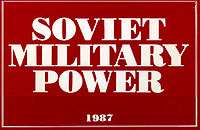Soviet Military Power

Soviet Military Power was a Public Diplomacy publication of the United States Department of Defense, which provided an estimate of the military strategy and capabilities of the Soviet Union during the final years of the Cold War, ostensibly to alert the U.S. public to the significant military capabilities of the Soviet Armed Forces. First published in early October, 1981, it became an annual publication from 1983 until the collapse of the Soviet Union in 1991. Already in draft as the Soviet Union collapsed, the 1991 version was retitled "Military Forces in Transition". In addition to the majority English version, Soviet Military Power was translated, printed, and disseminated in a variety of languages, including German, French, Japanese, Italian and Spanish.
The information in the publication was gleaned from various United States Intelligence Community members and intelligence sources but collated and written annually by intelligence analysts and subject matter experts from the Defense Intelligence Agency (DIA). By direction, draft inputs were written at a classified level prior to being edited or downgraded by senior intelligence officers with the proper authorities. To illustrate the publication, highly accurate detailed paintings of Soviet military hardware and installations were prepared by DIA artists to preclude the release of classified U.S. satellite imagery and the derivative revelation of sensor capabilities. Approximately 150 paintings were created expressly for Soviet Military Power. Some of this original artwork is on display in the 4th floor museum area of the Defense Intelligence Agency Headquarters on Bolling Air Force Base, Washington, D.C.

The Government Printing Office printed the approximate 100-page booklets; 1981's run numbered 36,000 copies, printed at a cost of $40,000. The booklets were widely distributed within the government, and to the press, and which the general public could purchase at local United States Post Offices (in 1981, for $6.50). At the time of initial publication, Soviet Military Power constituted the largest release of declassified data in Pentagon history. According to Secretary of Defense Caspar Weinberger, Soviet Military Power did not constitute any form of propaganda aimed at supporting the increasing defense budgets of the Reagan Administration but was designed instead to alert the American public to a growing imbalance between the military capabilities of the United States and the Soviet Union.
Accuracy
Following the fall of the Soviet Union, previously unavailable insights into the Soviet Armed Forces revealed a large and technologically capable force that suffered from severe equipment and facility maintenance shortfalls, and personnel training, morale, and retention issues. Claims of the accuracy of the intelligence estimates made in the annual Soviet Military Power publications have been thoroughly analyzed and evaluated in a scholarly Masters thesis by John A. Roberts, "The Validity of Soviet Military Power" . In 1988, journalist Tom Gervasi had attempted an analysis of the intelligence found within Soviet Military Power and came to the conclusion that many of the facts greatly overestimated actual Soviet forces and capabilities based on his research of alternate military publications such as those produced by Jane's Information Group and the International Institute of Strategic Studies. The validity of Gervasi’s conclusions, however, cannot be verified as much of the information he covered was still classified at the time of his publication and remains classified today.

Of the intelligence that has been declassified, it appears that much of the information found in Soviet Military Power publications was the best estimate of the United States Intelligence Community. Some of the facts may have been inaccurate, but these inaccuracies most likely represents disinformation or erroneous judgments on behalf of intelligence analysts rather than an intentional effort to mislead the American public.
References
- Roberts, John A. The Validity of Soviet Military Power, Masters thesis, ADA227470, 1990
- Gervasi, Tom. Soviet Military Power: The Pentagon’s Propaganda Document, Annotated and Corrected. New York: Random House, 1987. ISBN 0-394-75715-7
- Kelly, James and Bruce Nelan. Throwing the Booklet at Moscow. Time Magazine: Monday, Oct. 12, 1981.
- Oberg, James. Soviet Military Power: The Pentagon's Propaganda Document, Annotated and Corrected Book Review. National Review: Aug. 18, 1989.
- GlobalSecurity.org http://www.globalsecurity.org/military/world/russia/mig-29-specs.htm
- Haines, Gerald K. and Robert E. Leggett, eds. CIA's Analysis of the Soviet Union: 1947-1991. Washington D.C.: Center for the Study of Intelligence, 2001. ISBN 1-929667-08-6
External links
| ||||||||||||||||||||||||
